If you’ve heard of local search engine optimization (SEO), then you’re already on the right track. Some veteran business owners might also be optimizing for regional SEO, which is a step above local. But have you considered expanding your SEO efforts globally?
If that’s your plan, then international SEO is your answer. It’s a special branch of search engine optimization that focuses on targeting audiences in multiple countries and languages.
But how do you do it the right way? We’ll discuss that and more in this in-depth guide to international SEO. From the benefits of international SEO to must-do best practices, you’ll become one step closer to international success after reading this blog.
Here’s what we’ll discuss:
What Is International SEO?
5 Benefits of International SEO
1. Tap Into Emerging Markets
2. Overcome Language Barriers
3. Optimize for Local Search Trends
4. Build a Global Brand Presence
5. Edge Out International Competitors
12 Steps to Build an Effective International SEO Strategy
1. Identify Target Markets and Languages
2. Conduct Local Keyword Research
3. Utilize Hreflang Tags for Multilingual Content
4. Optimize for Regional Search Engines
5. Setup Your Google Search Console
6. Optimize Your GA4 for International Audiences
7. Use Language and Region-Specific URLs
8. Build Local Backlinks
9. Internationalize Your Content
10. Mobile-Friendly and Responsive Design
11. Integrate Your Content Delivery Networks
12. Regularly Update International Content
What Is International SEO?
Unlike local and regional SEO, where you target keywords to boost rankings, international SEO requires a more complex approach. It involves optimizing your website for different countries and languages, which means considering factors like:
• Cultural differences
• Language variations
• Technical and legal considerations for international operations
“International SEO is more complicated because it requires a comprehensive understanding of international markets, languages and cultures,” said Ronnel Viloria, Thrive’s Demand Generation Lead SEO Strategist.
“This also involves meticulous technical optimization and targeted content strategies to effectively reach and engage global audiences.”
This SEO strategy is used by multinational companies or businesses that are expanding to foreign locations. Implementing SEO for international markets means exploring a new arena of keywords, competition, market behavior and state regulations.
5 Benefits of International SEO
That sounds like a lot of work. Should you still do it? If you’re a local business that only focuses on one community, then international SEO marketing isn’t for you. However, there are several compelling reasons for the viability of international SEO services for companies expanding worldwide.
If you’re:
• An eCommerce store with access to platforms that ship globally
• A multi-location company with offices worldwide
• A globally recognized brand looking to increase visibility
Then, international SEO marketing matters more for you than you might think. Here are some of its benefits:
1. Tap Into Emerging Markets
“If done right, a global SEO strategy can greatly expand your market reach and audience, enhance your brand awareness globally and maximize your profit via global leads and sales,” Viloria said.
Emerging markets are economies that are steadily growing and becoming more engaged with global trade. These include countries like Brazil, China, India and Indonesia. If you’re expanding abroad, then you’re likely targeting them.
How did we know?
Because they offer a vast customer pool, so long as you speak their language and meet their cultural needs. International SEO strategies let you access these markets, which is something your competitors might not have done yet.
2. Overcome Language Barriers
An essential aspect of a global SEO strategy is language.
For example, in the U.S. and U.K. alone, there are already many differences between American and British English: Think of spelling variations, different expressions and even slang words.
Imagine expanding to a country with an entirely different language.That involves figuring out the proper use of keywords, when those keywords are likely used and how they can be strategically placed into your content.
Knowing these tiny little details prevents hiccups in messaging. Remember when Pepsi’s campaign slogan “Come alive with the Pepsi generation” which, when translated, read “Pepsi brings your ancestors back from the dead” in Chinese? Don’t let that be you.
You can easily avoid that barrier with proper research that is ingrained with international SEO.
3. Optimize for Local Search Trends
Let’s say you’re a U.K.-based company that sells hiking gear. Your SEO strategy is likely tailored to targeting keywords related to hiking and outdoor activities in the U.K.
This should include local search trends, such as “best hiking spots in England” or “hiking trails near London.”
But, if you expand to a country like Japan, your SEO strategy may need to be adjusted. You’ll want to target keywords and phrases that are relevant and popular in the Japanese market, such as “ハイキングギア” (hiking gear) and “日本のハイキングコース” (Japanese hiking trails).
A mere Google translation might not accurately capture the nuances and cultural context of these keywords, so it’s essential to work with a native speaker or global SEO services to ensure your website is optimized correctly for these trends.
4. Build a Global Brand Presence
Expanding your global reach involves a lot of moving parts:
• Marketing your brand and establishing relationships with local influencers
• Sourcing local supply chain companies to avoid long shipping times and high costs
• Repurposing your content for different cultures and languages
What’s not obvious about all these things is that they all involve a global SEO platform.
Local influencers want to work with someone they can easily find in search engines. Companies want to partner with someone reputable and search rankings are a vital indicator. Repurposed content shouldn’t be a bunch of blindly translated content.
SEO for international markets lets you appear more prominently in the proper context, building your presence in markets you’re not familiar with.
5. Edge Out International Competitors
Competitors in a new market already have a head start, but that doesn’t mean you can’t surpass them.
Global SEO services involve auditing your competitors’ websites and looking for opportunities to improve your strategies and techniques. This means looking at not just their content but also the following elements:
• Website structure
• Backlink profiles
• Social media presence
You need to enter a new market with a plan.
And just like everything else, a global SEO strategy plays a crucial role in that plan. Identify gaps, create better content and listen to the search trends of foreign markets. The strategies to know these things are not really different, but the context of how you do them is.
You can’t underestimate established international competition.
12 Steps To Build an Effective International SEO Strategy
So, how do you actually implement a global SEO platform? We’ll walk you through these 12 essential steps to get started:
1. Identify Target Markets and Languages
You might miss the mark if you don’t know who you’re trying to reach and where they’re located. That’s why you need to be specific about your target markets and the languages they speak. This informs the keywords you use, the content you create and even the design of your website.
“If you’re just starting to market your business globally, you need to put a lot of effort into researching how the market works in every country you are planning to do business in,” said Viloria.
Here are some tips on how to do this:
• Research Market Demographics: Use global SEO platform tools like Google Analytics to identify where current traffic comes from and potential markets based on interest in your products or services. This data is gold for spotting trends and opportunities.
• Analyze Competitor Markets: Look at where your local competitors focus their efforts. This reveals markets you might have overlooked or confirm the potential of markets you’re considering.
• Consider Language Nuances: As we said, it’s not just about translating content into a different language. You should also explore regional dialects and cultural nuances that resonate with an audience.
• Leverage Social Media Insights: Social media platforms offer insights into audience preferences and behaviors in different regions. Use this information to refine your target market selections.
• Engage in Local Forums and Online Communities: Participating in these spaces provides a deeper understanding of the needs and interests of customers in specific regions.
Combine all these data to form a solid foundation for your international SEO marketing strategy. By understanding the people in your next market and how they speak, you’ll have an easier time creating keywords and content they can relate to.
2. Conduct Local Keyword Research
Keywords are the bread and butter of SEO, so it’s essential to find them in your target market’s language. The right local keywords hit these points:
• Language: Keywords should be in the language of your target market, as search engines use this to determine relevance.
• Contextual Relevance: Not all words have a direct translation or impact in another language. Consider using culturally relevant phrases and idioms that people are more likely to search for.
• Search Volume: Use tools like Google Keyword Planner or Semrush to determine the search volume and competition for different keywords.
• Long-Tail Keywords: These are longer, more specific phrases that capture a user’s intent and have less competition. They can help you rank higher and reach a more targeted audience.
Let’s break down your keyword research with this table:
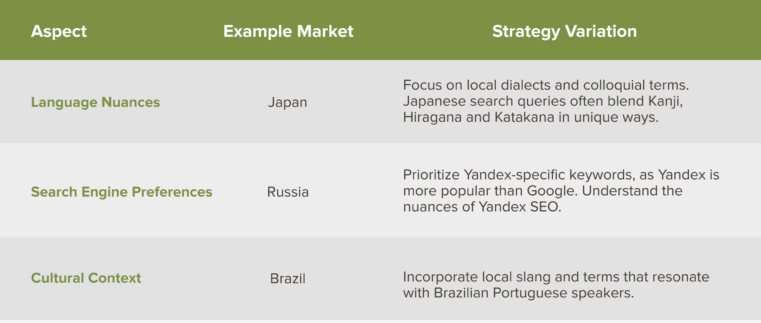
Don’t shy away from consulting with native speakers or international SEO services to ensure your keyword choices accurately reflect the language and culture of your target market. And as the markets evolve, new slangs and terms emerge as well. You have to be agile at detecting these changes and incorporate them into your international SEO strategies as needed.
3. Utilize Hreflang Tags for Multilingual Content
This is a more technical component of your international SEO strategy. And one that is very important since your context-specific content won’t rank well if it doesn’t match the user’s language and location.
“Properly implementing hreflang tags across all versions of your website assists search engines in delivering the most relevant version of your content to users,” Viloria said.
Hreflang tags tell search engines which version of your content to show based on the user’s location and preferred language.
Here are six steps to implement your website’s hreflang attribute:
1. Identify Language and Regional Variations: List out all the language and regional variations of your content. This involves deciding whether you’re targeting language, country, or a combination of both (e.g., en-GB for English speakers in the U.K.).
2. Create a URL Map: Develop a map of your site’s content showing the corresponding versions for each language and region. This helps in organizing how hreflang tags will be implemented across your site.
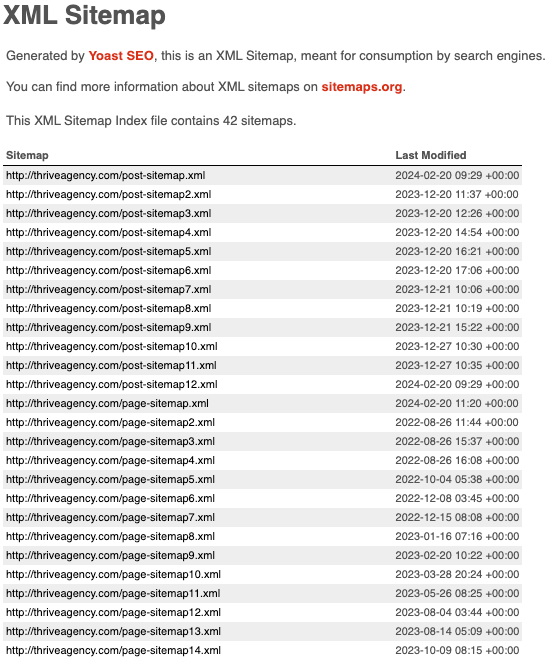
Screenshot: XML site map of a digital marketing agency
3. Use the Correct Format: Ensure you’re using the right format for your hreflang values. The format is generally “language-region”, where language is a two-letter ISO 639-1 code and region is a two-letter ISO 3166-1 Alpha-2 code. For global or non-specific targeting, just the language code can be used (e.g., “en” for English).
4. Implement Tags in Your Site’s Head: For each page, insert the hreflang tags in the <head> section of your HTML. This involves adding a link element for each language and regional variation, including a self-referencing link. The syntax looks like this: <link rel=”alternate” href=”http://example.com/en-gb” hreflang=”en-gb” />.
5. Include an “x-default” Tag: This tag is used for users whose languages are not specifically targeted by your website. It tells search engines which page to show by default. The syntax is similar to the above but with hreflang=”x-default.”
6. Validate Your Implementation: Use tools like Google Search Console or third-party validators to check that your hreflang tags are correctly implemented and recognized. This helps you spot and fix any errors.
Hreflang helps search engines understand the structure of your site and serve relevant results to users in their preferred language. It also helps ensure that the correct version of your content is shown to users based on their language and location.
4. Optimize for Regional Search Engines
According to Statista, Google still dominates at least 80% of the global search engine market. However, this shouldn’t stop you from considering other regional search engines, especially if you have a global reach or diverse audience.
You should know your target audience here: Where do they search? How do they search? What content do they prefer?
Here are four well-known regional search engines to optimize for:
1. Baidu: China’s largest search engine, with a 61.48% market share.
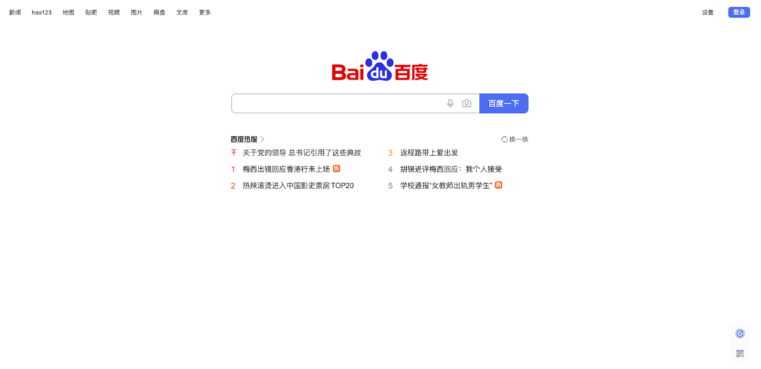
Screenshot from Baidu’s Homepage
2. Yandex: Russia’s leading search engine with 71% desktop search market share and 57.9% mobile search market share.
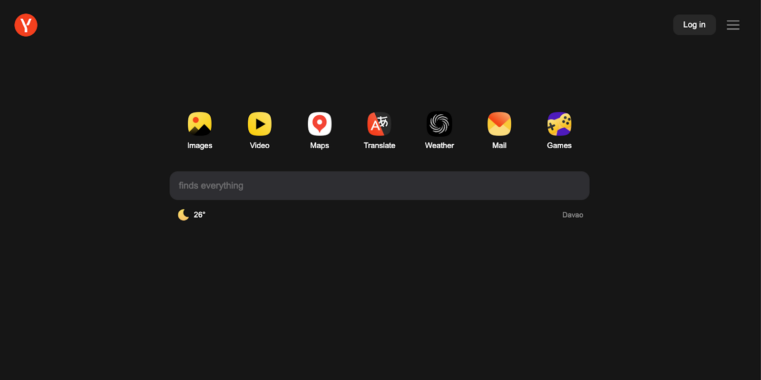
Screenshot from Yandex’s Homepage
3. Naver: South Korea’s most popular search engine, with a strong focus on local content and services. In 2022, Naver has a market share of 61.2% of monthly active users.
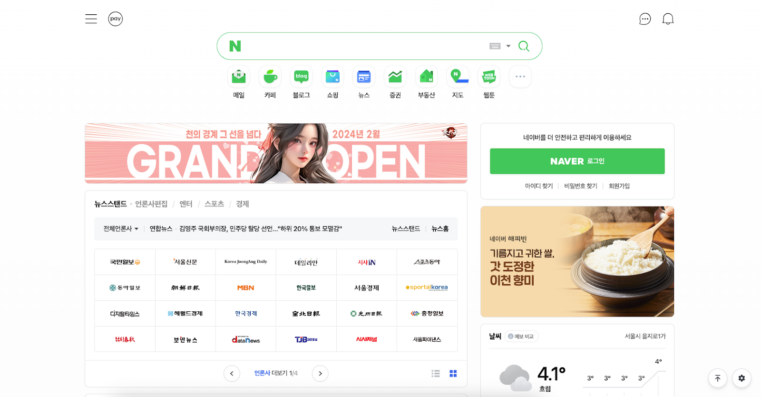
Screenshot from Naver’s Homepage
4. Bing: While not necessarily a regional search engine, it has significant market shares in some countries, such as the United States and the United Kingdom.
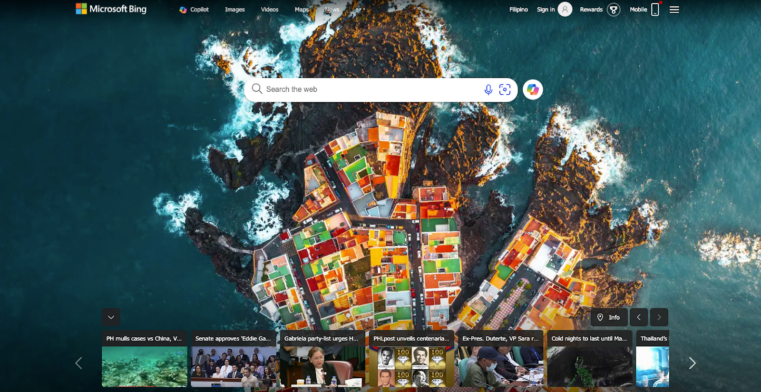
Screenshot from Bing’s Homepage
Each platform has its own algorithms and ranking factors, so it’s essential to understand how they work in order to optimize your content effectively. For instance, in a leaked document, Yandex’s algorithm includes ranking factors like PageRank, host reliability and freshness. It’s also vital to remember Baidu’s prioritization of its own services over external links in its search results.
5. Set Up Your Google Search Console
Google Search Console (GSC), formerly known as Google Webmaster Tools, is your hub for understanding how Google sees your website. It provides valuable insights on crawl errors, indexing status and search traffic data.
You can set up your GSC to optimize your website and content for international SEO:
• International Targeting: This allows you to set language preferences and target specific countries. You can use the hreflang tags to tell Google which language you are using on a specific page so the search engine can serve that page to users in that language.
• Geotargeting: Specifically target users in certain countries or regions. This is particularly useful if your website has different sections or domains dedicated to different locales.
• Preferred Domain: Specify which domain you prefer to be shown in search results, which is critical when you have multiple regional or language-specific versions of your site.
• Crawl Rate Adjustment: Adjust how frequently Googlebot crawls your site, which can be helpful if you’ve just updated content for a specific region and want it indexed quickly.
GSC doesn’t directly impact your search rankings, but it does provide valuable data and insights for optimizing your website’s technical aspects.
6. Optimize Your GA4 for International Audiences
While Google Analytics is primarily used for tracking website traffic, search marketing performance and user behavior, it’s also a powerful tool for international SEO.
Here are some points to effectively optimize GA4 for international audiences:
• Configure property settings to include country-specific tracking.
• Utilize audience segmentation for custom audience groups based on location, language or relevant criteria.
• Set up goals and conversion tracking to measure the success of localized content and marketing campaigns.
Tracking and analyzing data from different regions helps you identify patterns and trends, allowing you to make informed decisions for your international SEO strategies.
7. Use Language and Region-Specific URLs
Structuring your website’s URLs to reflect the language and region you are targeting also dramatically benefits your SEO for international markets.
For example, if your website has a section dedicated to French-speaking users in Canada, using a URL like “www.example.com/fr-ca/” helps search engines understand that this page is specifically for that audience.
A crucial part of this step is your top-level domain (TLD) selection. A TLD is the last part of a URL, such as “.com” or “.fr.”
We see three options for you to do this:

• Country Code Top-Level Domains (ccTLDs): These are two-letter domains specific to a country (e.g., .uk for the United Kingdom, .de for Germany). Using a ccTLD is a strong signal to search engines and users that your website is specifically targeted to that country, potentially improving your ranking in local search results.
• Generic Top-Level Domains (gTLDs) with Subdirectories: This involves using a generic domain like .com or .org and creating subdirectories for each country or language (e.g., example.com/en-gb for English speakers in the U.K.). This method keeps your site structure centralized while still allowing for localization.
• Subdomains with gTLDs: Another strategy is to use language or country-specific subdomains (e.g., uk.example.com). This approach is helpful in targeting specific regions or languages without needing multiple ccTLDs, though it may require more effort in building the domain’s authority from scratch.
You have to choose which option makes sense for your website. If you’re targeting multiple countries, ccTLDs may be the most effective. However, if you have limited resources and want to maintain a centralized site structure, gTLDs with subdirectories may be a better choice.
“Select a URL structure that aligns effectively with your international SEO goals and website framework,” said Viloria.
8. Build Local Backlinks
Unlike traditional SEO strategies, backlinking in international SEO services requires an increased focus on websites that are specific to your target countries. This means seeking out local directories, industry-specific sites and other sources that are popular in the regions you want to target.
Let’s say you’re a travel company based in the U.S. but want to attract customers from Germany. One way to build local backlinks would be to reach out to popular German travel blogs or websites and request a link exchange or guest posting opportunity.
Doing this gains you more visibility on your German audience and improves your chances of ranking higher in local search results.
9. Internationalize Your Content
This step is a major hack for those who already have tons of existing content. If you have a successful blog in English but want to expand your reach to other countries, you don’t have to start from scratch.
You can also incorporate local destinations, cultural references and language-specific keywords into your existing content.
Here are some must-try strategies when doing this step:
• Cultural Customization: Adapt your content to reflect local customs, values and societal norms. This may involve changing images, colors and themes to be culturally appropriate and resonate with the local audience.
• Local Language Nuances: Go beyond direct translation by localizing content to include regional dialects and idioms. This makes your content more relatable and ensures it feels natural to native speakers.
• Legal and Regulatory Compliance: Ensure your content meets the legal and regulatory requirements of each target market. This includes data privacy laws, advertising standards and any specific content restrictions.
• Local Trends and Search Behavior: Tailor your content to reflect local trends and the search behavior of your target audience. Use local keyword research to optimize your content for search engines specific to each region.
Viloria advises that your website should be “technically equipped to accommodate language and region-specific variations, such as currency, date formats and units of measurement.”
The goal here is to repurpose your content to be more relevant and appealing to a global audience. This leads to increased engagement, traffic and conversions from your international readers.
10. Mobile-Friendly and Responsive Design
Different languages, same demand for great user experience.
That’s what happens when you aim for global reach with your content. As more and more people access the internet from their mobile devices, it’s crucial to have a mobile-friendly and responsive design for your website.

Case Study: Metrology Services Company
People love responsive web designs. And because they love it, search engines are designed to rank them higher. This is a perfect example of how catering to the user experience can also benefit your SEO efforts.
(Read more: What is Responsive Web Design)
Here are some best practices you could use to do this:
• Fluid Grid Layouts: Use fluid grid systems that size elements in units that are relative like percentages, rather than fixed units like pixels, to ensure content scales smoothly across devices.
• Flexible Images: Implement techniques so images resize within their container elements, preventing them from displaying outside their containing element or becoming distorted on different screen sizes.
• Media Queries: Use CSS media queries to implement diverse styles depending on the screen size, resolution and orientation of the device, enabling a customized presentation for various devices.
• Touchscreen Navigation: Design for touchscreen navigation with easily clickable elements, considering the varying sizes of fingers and ensuring that navigation menus are accessible and user-friendly on touch devices.
Find what works best for your website and continually test and optimize to ensure your international audience has a seamless experience on all devices.
11. Integrate Your Content Delivery Networks
A Content Delivery Network (CDN) is a system of distributed servers that deliver web content and web pages to a user based on the following factors:
• Geographic location
• Origin of the webpage
• Content delivery server
CDNs are crucial when catering to an international audience since they reduce loading times, improve site speed and ensure users worldwide get your content quickly and reliably. Some examples of CDNs include Cloudflare, Akamai and Amazon CloudFront.
So, how do you integrate your CDN into your website? Here are some things to consider:
• Choose a CDN provider with a strong presence in your target markets to ensure your content is delivered as efficiently as possible to those regions.
• Implement caching strategies that optimize the types of content cached on the CDN, reducing the load on your origin server and speeding up content delivery.
• Monitor CDN performance and costs to ensure that you’re getting the best value and that your website’s performance meets the expectations of your international audience. Adjust configurations as necessary based on these insights.
With faster loading times and reliable content delivery, you can ensure that users from different regions have access to your website’s content without any delays or technical difficulties.
12. Regularly Update International Content
Now that you have everything set up, what’s next? Well, you don’t stop there. A sustainable international SEO strategy involves three things:
• Regularly creating new content
• Updating old content
• Analyzing performance
This means consistently reviewing your website’s international presence and making necessary adjustments to keep up with changing trends and user behavior in different regions. This improves your enterprise SEO but also ensures that your international audience remains engaged and interested in your brand.
So, don’t just set it and forget it – continue creating and optimizing your international content to reach a wider audience and stay ahead of the competition.
Expand Your Reach With Thrive
The journey towards international SEO success is not an easy one. Aside from being patient, you also have to be adaptable and willing to learn and improve continuously.
With Thrive’s global SEO services, you get all the perks without the hassle of going through it alone. Our team of experts, strategists and creatives all work together to ensure that your international SEO efforts are a success. From content creation and optimization to technical setup, we’ve got you covered.
Expand your brand globally with Thrive!








